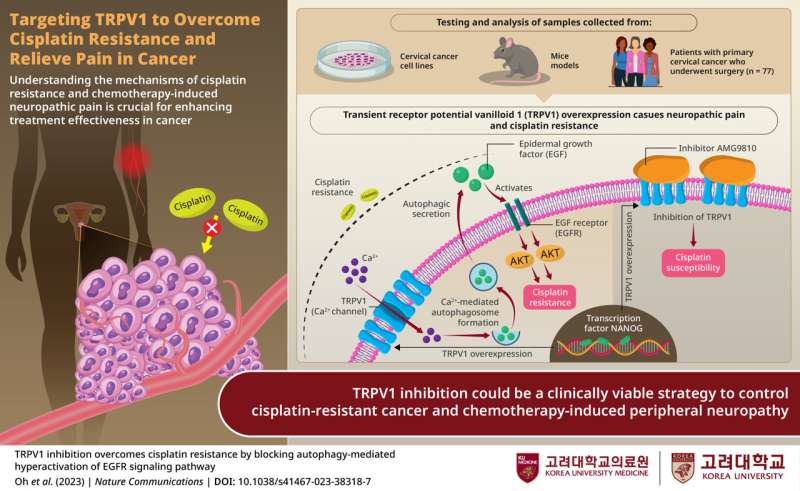This article has been reviewed according to Science X's editorial process and policies. Editors have highlighted the following attributes while ensuring the content's credibility:
fact-checked
peer-reviewed publication
proofread
Exploring ways to overcome cisplatin resistance and alleviate pain in cancer treatment

Cisplatin is a potent chemotherapeutic agent used to treat various cancers, including cervical cancer. But the continued use of cisplatin can lead to the development of cisplatin resistance and other side effects, like chemotherapy-induced neuropathic pain. Overcoming these issues is a critical concern in cervical cancer treatment.
Now, in a new study, Prof. Tae Woo Kim from Korea University Medicine and his team have explored the pathways leading to cisplatin resistance. Their study was published in Nature Communications.
The team analyzed the transcriptome of patients with cervical cancer who had undergone surgery and found that elevated epidermal growth factor receptor (EGFR) activity scores were associated with poor overall survival in cisplatin-treated patients.
"EGFR is a protein involved in cell signaling and its dysregulation leads to uncontrolled cell growth and tumor formation. We conducted experiments on EGFR signaling using cervical cancer cell lines and observed that the cisplatin-resistant cell line exhibited hyperactivated EGFR signaling compared to the cisplatin-susceptible cells. This led us to conclude that hyperactive EGFR triggers resistance mechanisms, leading to decreased drug effectiveness in tumor cells," explains Prof. Kim.
The team further identified NANOG, a transcription factor associated with resistance, metastasis, and stem cell-like properties in cancer cells, to be involved in the regulation of the EGFR pathway. They discovered that NANOG activates the transient receptor potential vanilloid 1 (TRPV1), which is responsible for causing neuropathic pain. TRPV1 further promotes a process called secretory autophagy, which leads epidermal growth factor (EGF) secretion. EGF, in turn, activates the EGFR signaling pathway, contributing to cisplatin resistance.
"Most noteworthily, in our study, inhibiting TRPV1 using AMG9810, a potential pain-relieving agent, rendered the resistant tumors vulnerable to cisplatin," says Prof. Kim.
This study serves as valuable proof-of-concept for TRPV1 as a therapeutic target to combat cisplatin resistance and neuropathic pain, thereby improving the outlook for patients with cervical cancer.
More information: Se Jin Oh et al, TRPV1 inhibition overcomes cisplatin resistance by blocking autophagy-mediated hyperactivation of EGFR signaling pathway, Nature Communications (2023). DOI: 10.1038/s41467-023-38318-7




















